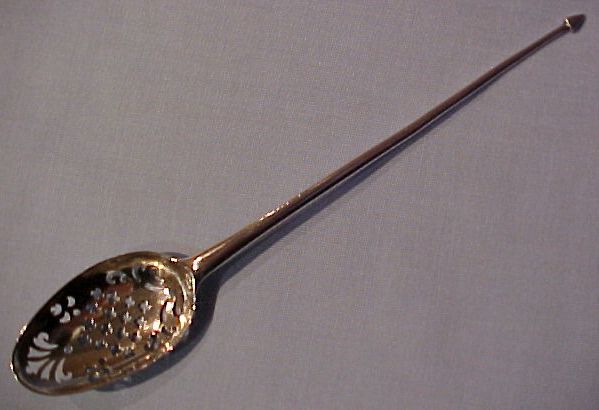| INDEX | ALL SILVER |
Mote Skimmers or Mote Spoons
A Few Introductory Notes by Ian Bedford

Skimmers or Spoons?
The term 'Mote Skimmer' accurately describes, in part, the
purpose of these items and 'Mote Spoon' clearly describes the derivation of the
article, for spoons long predate any need for mote skimming. I prefer the more
descriptive but less recognised term of Mote Skimmer, however, throughout the
reign of Queen Anne they were known as 'long tea spoons'.
Mote
An Old English word
for a particle of dust or foreign matter, particularly in food and drink. Mote
Skimmers appear shortly after the introduction of tea and an inspection of
Georgian and earlier tea would show why. The Georgians had no mechanical
means of removing the 'dust' and as Georgian tea was sold in the leaf, that is,
still whole, the 'dust' could be quite large once it had re-hydrated. This
explains the larger piercings
than one might have anticipated.
Usage
Principally to skim the mote from your tea infusion using the
bowl and secondly to clear it from or perforate the leaves caught on the grill within the tea
pot using the point (usually diamond shaped) at the end of the slender stem. The
London Gazette of 1697 makes reference to "long or strainer tea spoons with
narrow pointed handles" and early/mid eighteenth century examples have been
found en suite with tea caddies, sugar boxes, tea tongs and tea spoons, although
not with caddy spoons. If your position allowed it in Georgian England, then the skimming could
be done by your 'tea blender', usually your most presentable house or parlour
maid, before it was handed to your guests. During informal occasions you would
usually do it for yourself. Exceptionally large examples, usually of the George
III period, were designed for use with contemporary tea urns.
There is a third possible usage that has chronological support although I have, as yet, found no supporting historical
documentary evidence for it.
When tea was introduced to England it was almost prohibitively expensive, but the price began a gradual decline, continuing until
the present day. In 1660 Pepys (the noted diarist) comments that he found to drink tea was 'favourable'. A most understated remark for a luxury that cost
three pounds and ten shillings a pound for the best quality, an amount equivalent to the annual salary for a maid and considerably beyond Pepys own
means at the time. By 1700 the price of good tea was around one pound per pound and by the middle of the century it was about half that amount. Thomas Turner, a
merchant from the now East Sussex village of East Hoathley notes in his diary that on the 1st of August 1759 he paid nine shillings and three pence for a
pound of best green tea. This was at a time when meat cost around three pence a pound and lobster four pence a pound. Tea was expensive and it seems almost
unimaginable that no silversmith had created a special piece of equipment for ladling it from its specially created caddy to its purpose designed and crafted
infusing pot and then into special bowls or cups to be stirred with purpose built spoons. As tea became cheaper and so drunk in larger quantities by many
more people, a specially designed silver spoon does appear, what we call today the caddy spoon. Early caddy spoons of the eighteenth century even have filigree
centres to their bowls, perhaps reminiscent of mote skimmers. It would be an unlikely coincidence that the rise in popularity of the silver caddy spoon
mirrors the decline of the mote skimmer and so it is plausible that mote skimmers were also to ladle measured amounts of leaf tea into the pot. The
piercings would also aid the tapping out of any smaller, dust like particles.
| back |